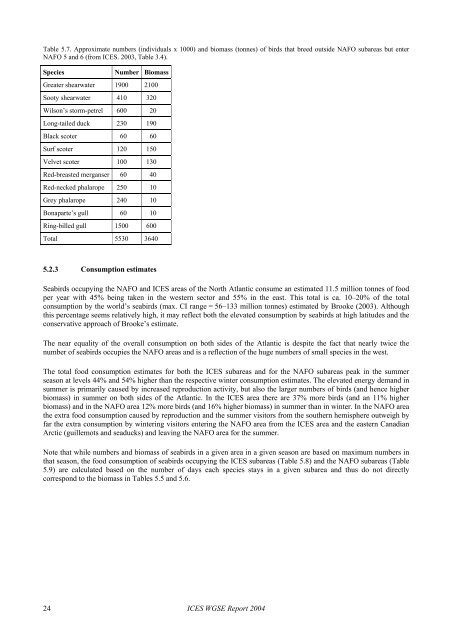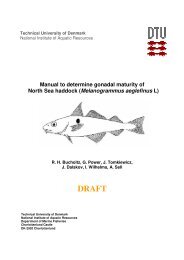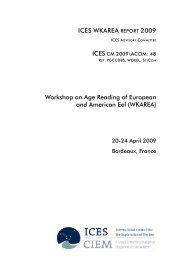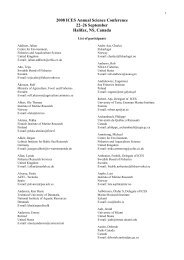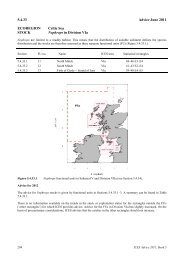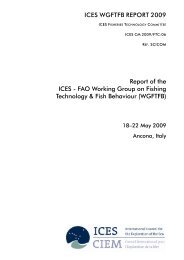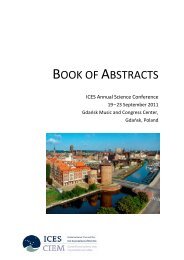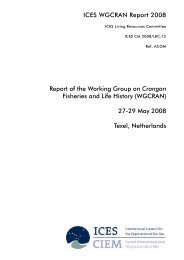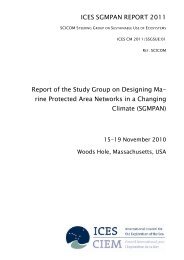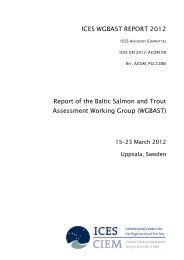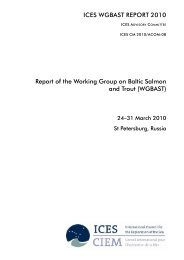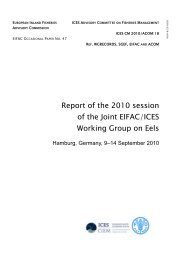Working Group on Seabird Ecology (WGSE). ICES CM 2004/C:05 ...
Working Group on Seabird Ecology (WGSE). ICES CM 2004/C:05 ...
Working Group on Seabird Ecology (WGSE). ICES CM 2004/C:05 ...
- TAGS
- seabird
- ecology
- ices
- www.ices.dk
You also want an ePaper? Increase the reach of your titles
YUMPU automatically turns print PDFs into web optimized ePapers that Google loves.
Table 5.7. Approximate numbers (individuals x 1000) and biomass (t<strong>on</strong>nes) of birds that breed outside NAFO subareas but enter<br />
NAFO 5 and 6 (from <strong>ICES</strong>. 2003, Table 3.4).<br />
Species Number Biomass<br />
Greater shearwater 1900 2100<br />
Sooty shearwater 410 320<br />
Wils<strong>on</strong>’s storm-petrel 600 20<br />
L<strong>on</strong>g-tailed duck 230 190<br />
Black scoter 60 60<br />
Surf scoter 120 150<br />
Velvet scoter 100 130<br />
Red-breasted merganser 60 40<br />
Red-necked phalarope 250 10<br />
Grey phalarope 240 10<br />
B<strong>on</strong>aparte’s gull 60 10<br />
Ring-billed gull 1500 600<br />
Total 5530 3640<br />
5.2.3 C<strong>on</strong>sumpti<strong>on</strong> estimates<br />
<strong>Seabird</strong>s occupying the NAFO and <strong>ICES</strong> areas of the North Atlantic c<strong>on</strong>sume an estimated 11.5 milli<strong>on</strong> t<strong>on</strong>nes of food<br />
per year with 45% being taken in the western sector and 55% in the east. This total is ca. 10–20% of the total<br />
c<strong>on</strong>sumpti<strong>on</strong> by the world’s seabirds (max. CI range = 56–133 milli<strong>on</strong> t<strong>on</strong>nes) estimated by Brooke (2003). Although<br />
this percentage seems relatively high, it may reflect both the elevated c<strong>on</strong>sumpti<strong>on</strong> by seabirds at high latitudes and the<br />
c<strong>on</strong>servative approach of Brooke’s estimate.<br />
The near equality of the overall c<strong>on</strong>sumpti<strong>on</strong> <strong>on</strong> both sides of the Atlantic is despite the fact that nearly twice the<br />
number of seabirds occupies the NAFO areas and is a reflecti<strong>on</strong> of the huge numbers of small species in the west.<br />
The total food c<strong>on</strong>sumpti<strong>on</strong> estimates for both the <strong>ICES</strong> subareas and for the NAFO subareas peak in the summer<br />
seas<strong>on</strong> at levels 44% and 54% higher than the respective winter c<strong>on</strong>sumpti<strong>on</strong> estimates. The elevated energy demand in<br />
summer is primarily caused by increased reproducti<strong>on</strong> activity, but also the larger numbers of birds (and hence higher<br />
biomass) in summer <strong>on</strong> both sides of the Atlantic. In the <strong>ICES</strong> area there are 37% more birds (and an 11% higher<br />
biomass) and in the NAFO area 12% more birds (and 16% higher biomass) in summer than in winter. In the NAFO area<br />
the extra food c<strong>on</strong>sumpti<strong>on</strong> caused by reproducti<strong>on</strong> and the summer visitors from the southern hemisphere outweigh by<br />
far the extra c<strong>on</strong>sumpti<strong>on</strong> by wintering visitors entering the NAFO area from the <strong>ICES</strong> area and the eastern Canadian<br />
Arctic (guillemots and seaducks) and leaving the NAFO area for the summer.<br />
Note that while numbers and biomass of seabirds in a given area in a given seas<strong>on</strong> are based <strong>on</strong> maximum numbers in<br />
that seas<strong>on</strong>, the food c<strong>on</strong>sumpti<strong>on</strong> of seabirds occupying the <strong>ICES</strong> subareas (Table 5.8) and the NAFO subareas (Table<br />
5.9) are calculated based <strong>on</strong> the number of days each species stays in a given subarea and thus do not directly<br />
corresp<strong>on</strong>d to the biomass in Tables 5.5 and 5.6.<br />
24<br />
<strong>ICES</strong> <strong>WGSE</strong> Report <strong>2004</strong>


